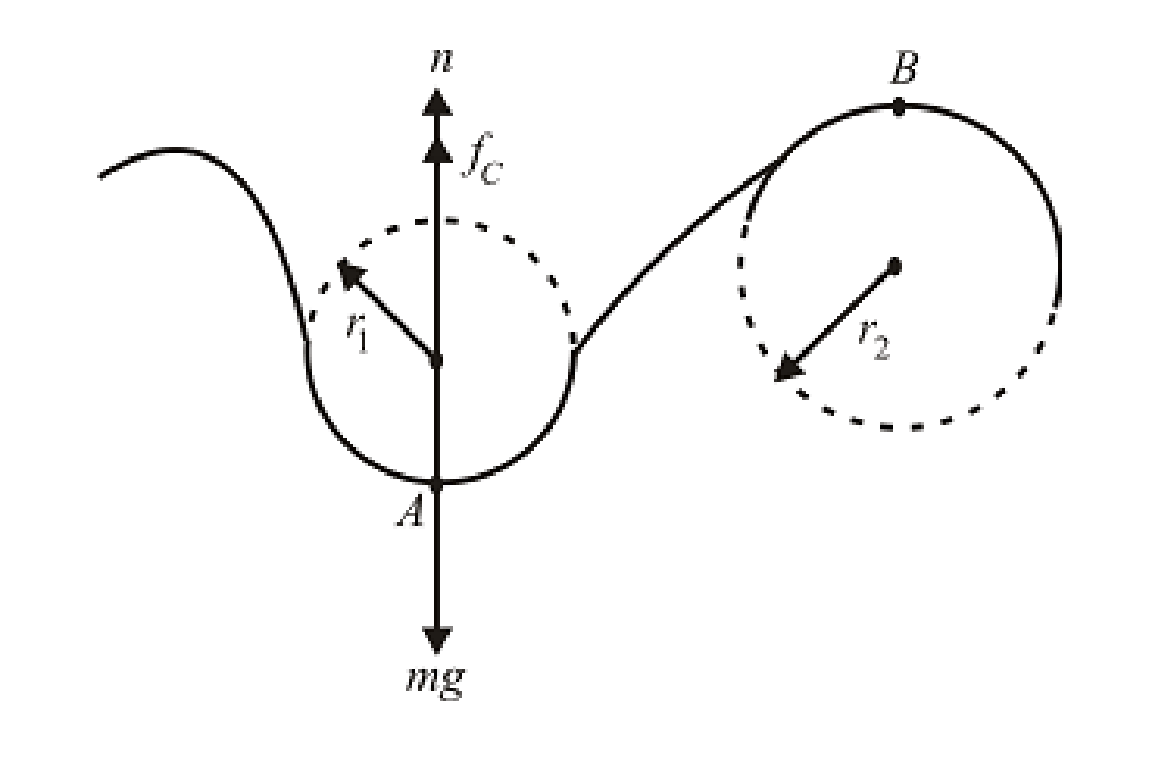
(a)
The forceexerted by the track on the fully loaded roller-coaster at point
(a)
Answer to Problem 16P
The forceexerted by the track on the fully loaded roller-coaster at point
Explanation of Solution
Consider the fully loaded roller-coaster car is moving on a curved path which has a radius of curvature. If the roller-coaster car rotates on a circular path, then it experiences a force acts towards the center of the circle which is known as
The magnitude of centripetal force
- 1. The speed of the roller-coaster car.
- 2. The mass of the roller-coaster car.
- 3. The radius of curvature of the curve path.
The forces act on the fully loaded roller-coaster car when it is at point

Write the expression for the fully loaded roller-coaster car corresponding to Newton’s second law in
Here,
Write the expression for centripetal acceleration as.
Here,
Substitute
Simplify the above expression for
Conclusion:
Substitute
Thus, the force exerted by the track on the fully loaded roller-coaster at point
(b)
The maximum speed the vehicle can have at point
(b)
Answer to Problem 16P
The maximum speed the vehicle can have at point
Explanation of Solution
The direction of the centrifugal force and the normal force exerted by the track on the fully loaded roller-coaster is in same direction. As the speed of the car increases, the centripetal force increase which results decrease in normal reaction force.
The car keeps on track because of normal force reaction exerted by the track on the car.
At the verge to keep the car on the track, the normal force exerted by the track on the car is equal to zero. If the normal reaction force is equal to zero, then weight of the car will be equal to the centripetal force.
Write the expression for the condition of a car to keep on the track as.
Here,
Write the expression for centrifugal force acts on the car at point
Here,
Substitute
Re-arrange the terms
Simplify the above expression for
Conclusion:
Substitute
Thus, the maximum speed the vehicle can have at point
Want to see more full solutions like this?
Chapter 6 Solutions
Physics For Scientists And Engineers With Modern Physics, 9th Edition, The Ohio State University
- A particle with a charge of − 5.20 nC is moving in a uniform magnetic field of (B→=−( 1.22 T )k^. The magnetic force on the particle is measured to be(F→=−( 3.50×10−7 N )i^+( 7.60×10−7 N )j^. Calculate the scalar product v→F→. Work the problem out symbolically first, then plug in numbers after you've simplified the symbolic expression.arrow_forwardNeed help wity equilibrium qestionarrow_forwardneed answer asap please thanks youarrow_forward
- A man slides two boxes up a slope. The two boxes A and B have a mass of 75 kg and 50 kg, respectively. (a) Draw the free body diagram (FBD) of the two crates. (b) Determine the tension in the cable that the man must exert to cause imminent movement from rest of the two boxes. Static friction coefficient USA = 0.25 HSB = 0.35 Kinetic friction coefficient HkA = 0.20 HkB = 0.25 M₁ = 75 kg MB = 50 kg P 35° Figure 3 B 200arrow_forwardA golf ball is struck with a velocity of 20 m/s at point A as shown below (Figure 4). (a) Determine the distance "d" and the time of flight from A to B; (b) Determine the magnitude and the direction of the speed at which the ball strikes the ground at B. 10° V₁ = 20m/s 35º Figure 4 d Barrow_forwardThe rectangular loop of wire shown in the figure (Figure 1) has a mass of 0.18 g per centimeter of length and is pivoted about side ab on a frictionless axis. The current in the wire is 8.5 A in the direction shown. Find the magnitude of the magnetic field parallel to the y-axis that will cause the loop to swing up until its plane makes an angle of 30.0 ∘ with the yz-plane. Find the direction of the magnetic field parallel to the y-axis that will cause the loop to swing up until its plane makes an angle of 30.0 ∘ with the yz-plane.arrow_forward
- A particle with a charge of − 5.20 nC is moving in a uniform magnetic field of (B→=−( 1.22 T )k^. The magnetic force on the particle is measured to be (F→=−( 3.50×10−7 N )i^+( 7.60×10−7 N )j^. Calculate the y and z component of the velocity of the particle.arrow_forwardneed answer asap please thank youarrow_forward3. a. Determine the potential difference between points A and B. b. Why does point A have a higher potential energy? Q = +1.0 C 3.2 cm 4.8 cm Aarrow_forward
 Principles of Physics: A Calculus-Based TextPhysicsISBN:9781133104261Author:Raymond A. Serway, John W. JewettPublisher:Cengage Learning
Principles of Physics: A Calculus-Based TextPhysicsISBN:9781133104261Author:Raymond A. Serway, John W. JewettPublisher:Cengage Learning Physics for Scientists and Engineers: Foundations...PhysicsISBN:9781133939146Author:Katz, Debora M.Publisher:Cengage Learning
Physics for Scientists and Engineers: Foundations...PhysicsISBN:9781133939146Author:Katz, Debora M.Publisher:Cengage Learning Glencoe Physics: Principles and Problems, Student...PhysicsISBN:9780078807213Author:Paul W. ZitzewitzPublisher:Glencoe/McGraw-Hill
Glencoe Physics: Principles and Problems, Student...PhysicsISBN:9780078807213Author:Paul W. ZitzewitzPublisher:Glencoe/McGraw-Hill Physics for Scientists and Engineers with Modern ...PhysicsISBN:9781337553292Author:Raymond A. Serway, John W. JewettPublisher:Cengage Learning
Physics for Scientists and Engineers with Modern ...PhysicsISBN:9781337553292Author:Raymond A. Serway, John W. JewettPublisher:Cengage Learning Physics for Scientists and EngineersPhysicsISBN:9781337553278Author:Raymond A. Serway, John W. JewettPublisher:Cengage Learning
Physics for Scientists and EngineersPhysicsISBN:9781337553278Author:Raymond A. Serway, John W. JewettPublisher:Cengage Learning Classical Dynamics of Particles and SystemsPhysicsISBN:9780534408961Author:Stephen T. Thornton, Jerry B. MarionPublisher:Cengage Learning
Classical Dynamics of Particles and SystemsPhysicsISBN:9780534408961Author:Stephen T. Thornton, Jerry B. MarionPublisher:Cengage Learning





